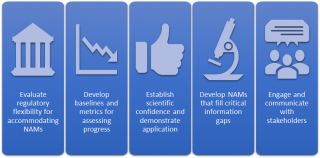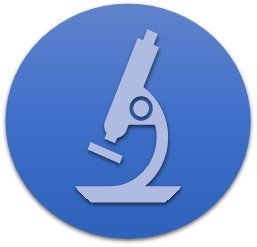EPA New Approach Methods Work Plan: Reducing Use of Vertebrate Animals in Chemical Testing

EPA uses information from a broad range of vertebrate animal tests to evaluate the potential risks of chemicals, assess potential impacts on the environment, and approve chemicals for certain uses. EPA's New Approach Methods (NAMs) Work Plan was created to prioritize agency efforts and resources toward activities that aim to reduce the use of vertebrate animal testing while continuing to protect human health and the environment. The original EPA NAMs Work Plan was released in June 2020 and laid out the Agency’s objectives and strategies. The updated EPA NAMs Work Plan was released in December 2021.
The Work Plan includes the following objectives:
- Evaluate Regulatory Flexibility for Accommodating NAMs
- Develop Baselines and Metrics for Assessing Progress
- Establish Scientific Confidence in NAMs and Demonstrate Application to Regulatory Decisions
- Develop NAMs to Address Scientific Challenges and Fill Important Information Gaps
- Engage and Communicate with Stakeholders
Evaluate Regulatory Flexibility for Accommodating NAMs

To consider options for using appropriate NAMs for regulatory purposes, EPA staff performed a thorough review of existing statutes and programmatic regulations, policies and guidance to identify vertebrate animal testing requirements that may allow flexibility for the Agency to apply NAMs in decision-making. The Agency’s comprehensive review titled, EPA Report on Statutory and Regulatory Requirements for Vertebrate Animal Testing and Flexibility for Implementing New Approach Methods (NAMs), was issued in September 2024.
Develop Baselines and Metrics for Assessing Progress

EPA will build on previously established baselines and metrics for vertebrate animal use within the Office of Chemical Safety and Pollution Prevention and Office of Research and Development. This approach will then be progressively extended to other EPA offices, taking into account that specific baselines and metrics will need to be customized to fit the specific needs of each program.
Establish Scientific Confidence in NAMs and Demonstrate Application t0 Regulatory Decisions

To establish scientific confidence in NAMs EPA will first characterize the scientific quality and relevance of traditional tests using laboratory vertebrate animals, then develop a scientific confidence framework to evaluate the quality, reliability and relevance of NAMs.
The application of NAMs to different regulatory decisions will be demonstrated through case studies, with approximately one case study each year beginning in 2023.
Develop NAMs to Address Scientific Challenges and Fill Important Information Gaps

To help fill important information gaps in chemical safety research EPA will facilitate joint development of NAMs by EPA scientists and regulators. To foster this collaboration EPA will develop research plans on a regular 4-year planning cycle.
EPA will also collaborate with stakeholders outside the agency to encourage the development and evaluation of NAMs through STAR grants and partnerships with organizations working to establish scientific confidence in alternative methods.
Engage and Communicate with Stakeholders

A centralized portal for releasing EPA-related NAM information will be updated regularly to ensure transparency and accountability, with comments and feedback from stakeholders being actively solicited.
EPA will also hold training courses, workshops and conferences for interested stakeholders to learn more about NAM research and data.
Contact
If you have feedback about the EPA New Approach Methods Work Plan please contact NAM@EPA.gov
